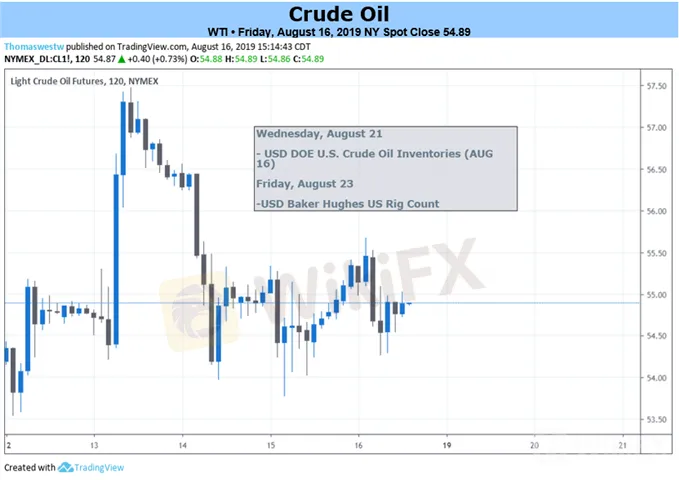简体中文
繁體中文
English
Pусский
日本語
ภาษาไทย
Tiếng Việt
Bahasa Indonesia
Español
हिन्दी
Filippiiniläinen
Français
Deutsch
Português
Türkçe
한국어
العربية
Sliding Crude Oil Cant Look to Jackson Hole For Price Support
Abstract:Crude oil prices continue to drop as the economic data keep huge question marks glowering over likely demand levels.

Fundamental Crude Oil Forecast: Bearish
Last week was rough for crude
German data disappointed, inventories rose
The coming week may be no worse, but its hard to see durable price gains ahead
Crude oil prices are likely to remain biased lower as investors fret likely end demand in a world economy beset with horrific uncertainties and slowing obviously across many key regions. Prices have been biased lower all year on these worries and their slide has accelerated since mid-July.
It shows little sign of abating and, really, why would it?
Last week brought plenty of grim news. Germany‘s economy was found to have contracted in this year’s second quarter raising the specter of technical recession in Europe‘s engine room. US bond yields also slid, telling their own doleful tale about investors’ take on likely growth ahead.
Germany Add to Gloom
The coming week will bring more inventory numbers from the US Department of Energy. However, the overall market focus is likely to be well beyond these and rather on global economic prospects, trade headlines and the Kansas City Federal Reserves annual meeting of central banking heavyweights at Jackson Hole.
It‘s very hard to see how the guest list there can be other than extremely cautious on the outlook even if they’re likely to put the best gloss they can on a discomfiting economic vista.

Resources for Traders
Disclaimer:
The views in this article only represent the author's personal views, and do not constitute investment advice on this platform. This platform does not guarantee the accuracy, completeness and timeliness of the information in the article, and will not be liable for any loss caused by the use of or reliance on the information in the article.
Read more

Fed Rate Cut Calls, Would NFP Tilt The Odds?
The latest data for the U.S. ISM Manufacturing PMI, released on August 1, 2024, shows a decline to 46.8, down from 48.5 in June. This marks the sixth consecutive month of contraction (a reading below 50) and remains well below the historical average of 52.88. On July, the Bank of Canada (BoC) announced a 25-basis-point cut in its benchmark interest rate, reducing it to 4.5%. This was the second consecutive rate cut, following a similar move in June. The latest ADP Nonfarm Employment Change for..

Fed Pressured: Will CPI Data Fuels Calls for Rate Cuts?
The U.S Producer Price Index (PPI) for June showed a month-over-month increase of 0.2%, which was slightly above market expectations of 0.1%. The Reserve Bank of New Zealand (RBNZ) recently kept its Official Cash Rate (OCR) unchanged at 5.50% during its last meeting on July 2024, which was consistent with market expectations. As of June 2024, the U.S. Consumer Price Index (CPI) showed a modest increase of 3.0% year-over-year, weaker than market expectation and previous reading of 3.1% and 3.3%..

Fed Rate Cut Locked In? All Eyes on PCE!
The latest S&P Global US Manufacturing PMI for June 2024 has been revised to 51.6, slightly lower than the expectation of 51.7 but up from 51.3 in May. In its most recent decision in June, the Bank of Canada (BoC) reduced its key interest rate by 25 basis points, lowering it from 5% to 4.75% in response to easing inflation indicators. In the first quarter of 2024, the US economy expanded at an annualized rate of 1.4%, slightly surpassing market expectations of 1.3%. This growth marked a...

Powell’s Dovish Tone Hammers Dollar
Federal Reserve Chair Jerome Powell indicated that recent U.S. economic data suggest inflation is returning to a downward trajectory. However, he emphasised the need for more evidence before the Fed considers shifting its current monetary policy. Consequently, the dollar eased from its recent highs, while U.S. equity markets, buoyed by the dovish tone, saw the Nasdaq and S&P 500 reaching all-time highs.
WikiFX Broker
Latest News
FCA Warns Against 10 Unlicensed or Clone Firms
CySEC Warns Against 14 Unlicensed Investment Websites
Top Currency Pairs to Watch for Profit This Week - March 31, 2025
Will natural disasters have an impact on the forex market?
Philippines Deports 29 Indonesians Linked to Online Scam Syndicate in Manila
Exposing the Top 5 Scam Brokers of March 2025: A Closer Look by WikiFX
Gold Prices Climb Again – Have Investors Seized the Opportunity?
Webull Launches SMSF Investment Platform with Zero Fees
Australian Regulator Warns of Money Laundering and Fraud Risks in Crypto ATMs
The Withdrawal Trap: How Scam Brokers Lure Victims into Paying More
Currency Calculator







